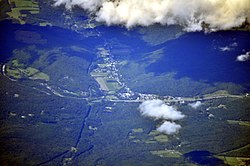Roscoe, New York
| Roscoe, New York | |
|---|---|
| CDP | |

Aerial view of Roscoe from the south (2013)
|
|
 U.S. Census Map |
|
 Location of Roscoe in Sullivan County, New York |
|
| Coordinates: 41°56′10″N 74°54′58″W / 41.93611°N 74.91611°WCoordinates: 41°56′10″N 74°54′58″W / 41.93611°N 74.91611°W | |
| Country | United States |
| State | New York |
| County | Sullivan |
| Area | |
| • Total | 0.7 sq mi (1.9 km2) |
| • Land | 0.7 sq mi (1.9 km2) |
| • Water | 0.0 sq mi (0.0 km2) |
| Elevation | 1,296 ft (395 m) |
| Population (2010) | |
| • Total | 541 |
| Time zone | Eastern (EST) (UTC-5) |
| • Summer (DST) | EDT (UTC-4) |
| ZIP code | 12776 |
| Area code(s) | 607 Exchange: 498 |
| FIPS code | 36-63583 |
| GNIS feature ID | 0962895 |
Roscoe is a hamlet (and census-designated place) in Sullivan County, New York, United States. The population was 541 at the 2010 census.
Roscoe is in the southwest part of the Town of Rockland, adjacent to New York State Route 17.
It is named for New York Senator Roscoe Conkling.
Roscoe calls itself the "Trout Town, USA." The town is a destination for fly-fishing enthusiasts because of its location at the intersection of two rivers popular for trout fishing (the Beaver Kill and the Willowemoc Creek). The community is a traditional stopping point for people traveling along Route 17 (between New York City and Binghamton, New York) because the facilities are right by the access road to the highway. These include gas stations and convenience stores.
In 1789 Roscoe was called Westfield Flats. It was the home of the Delaware Indians, where wolves roamed freely.
Roscoe, like most of the Catskills, was part of the Hardenbergh Patent in the early 18th century which in turn was purchased by the last Lord of the Manor of Livingston Manor, Robert Livingston. The first settlers were brothers who bought the area around Roscoe from Livingston's son Jonathan Livingston. Stewart Street is one of the community's main streets.
During the construction of New York State Route 17 (Southern Tier Expressway), the section near Roscoe was one of the last to be completed, requiring travelers to exit onto the local truck roads for several miles.
...
Wikipedia
